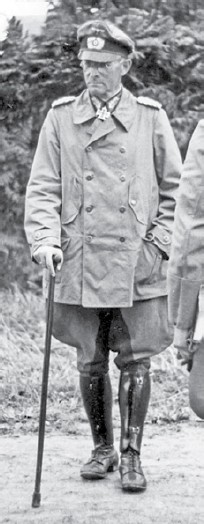
The supreme commander for German forces in the west (Oberbefehlshaber West) was Generalfeldmarschall Gerd von Rundstedt. His headquarters controlled two army groups in France, Heeresgruppe B on the invasion front in northern France, and Heeresgruppe G in central and southern France. Generalfeldmarschall Erwin Rommel was assigned to command Heeresgruppe B on the invasion front in the autumn of 1943. Rommel considerably invigorated the defense effort, and put his own stamp on the anti-invasion tactics.

General der Artillerie Erich Marcks, commander of LXXXIV Armee Korps (84. AK). (Alain Chazette)
Defense of the Cotentin Peninsula was the responsibility of the 7. Armee (AOK 7), commanded by Generaloberst Friedrich Dollmann. This field army controlled the French coast from the mouth of the Loire near St Nazaire eastward to the Pas-de-Calais and included all German Army units in Normandy and Brittany. Dollmann was a corps commander in Poland in 1939, and assigned command of AOK 7 in the Battle of France in 1940. He remained in command during the years of occupation. Some Eastern Front veterans serving in France felt that the years of occupation duty had softened him and his staff. Dollmann died of a heart attack on June 28, 1944, less than a month after D-Day.
The Lower Normandy sector, including the Cotentin Peninsula, was the responsibility of the LXXXIV Armee Korps (84. AK), commanded by General der Artillerie Erich Marcks. He served as a staff officer in Poland in 1939 and France in 1940. Marcks took part in the planning for Operation Barbarossa, and led the 101. Jäger-Division during the Russian campaign in 1941. He lost a leg in combat in March 1942, and, following his recuperation, was reassigned to lead the 337. Infanterie-Division. His skills as a divisional commander led to his elevation to corps command, first the 66. AK in September 1942, then the 87. AK. He was passed over by Hitler for field army command because of his connections to Gen. von Schleicher, murdered by the SS in 1934. Instead, he was reassigned to the 84. AK in France on August 1, 1943, as part of the process of refreshing the command structure in France with experienced Russian Front veterans. The 84. AK headquarters were located at St Lô. Marcks was killed in Normandy by an air attack on June 12, 1944.
The unit most closely associated with the defense of the Cotentin Peninsula was the 709. Infanterie-Division, commanded by Generalleutnant Karl Wilhelm von Schlieben. An infantry veteran of World War I, Schlieben had been most closely associated with the Panzer force, leading a Panzergrenadier Regiment of the 1. Panzer-Division in the Battle of France in 1940, a rifle brigade of the 4. Panzer-Division in 1942, and then 18. Panzer-Division during the battle of Kursk in 1943. The 18. Panzer-Division took such heavy casualties at Kursk that it was disbanded, and Schlieben was placed in reserve. He was appointed to command the 709. Infanterie-Division in December 1943 and was elevated to Generalleutnant on May 1, 1944. The division’s headquarters were located in a bunker complex near the Château de Chiffrevast, to the north of Valognes.
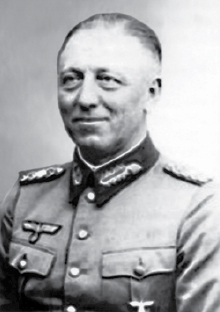
Generalleutnant Heinz Hellmich, commander of the 243. Infanterie-Division and the later Kampfgruppe Hellmich. (MHI)
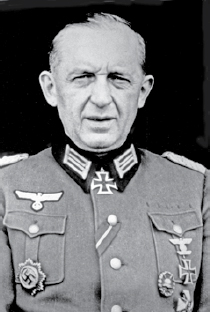
Generalleutnant Karl Wilhelm von Schlieben, commander of 709. Infanterie-Division (Bodenständig), and commander of Festung Cherbourg after June 23, 1944. (MHI)
The western side of the Cotentin Peninsula was defended by another static division, the 243. Infanterie-Division, commanded by Generalleutnant Heinz Hellmich. He led the 23. Infanterie-Division in France in 1940 and in Russia in 1941–42. After commanding a reserve division, he was assigned to lead the 243. Infanterie-Division on January 10, 1944. Hellmich was killed in an air attack on June 17, 1944.
The third Cotentin division, the newly formed 91. Luftlande-Division, had been commanded by Generalleutnant Wilhelm Falley since April 25, 1944. He had started the war as an infantry battalion commander, and led an infantry regiment in Russia in 1941 where he was awarded the Knight’s Cross. After further service on the Russian front, he took over a succession of battered infantry divisions starting in September 1943. He was the first German general killed in Normandy after an encounter with US paratroopers in the pre-dawn hours of D-Day. Command was temporarily taken over by Generalmajor Bernhard Klosterkemper awaiting the arrival of a new commander, Generalmajor Eugen König, who was assigned the post on June 7.
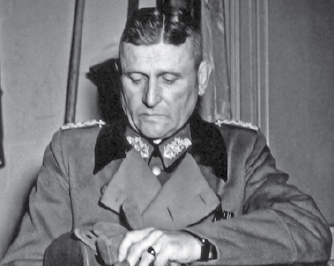
Generalmajor Robert Sattler was the commander of Festung Cherbourg until June 23 when Schlieben was appointed commander; Sattler then became his deputy. (NARA)
The Cherbourg commandant was Generalmajor Robert Sattler. He was a decorated World War I veteran and served in the Reichswehr after the war. He commanded an infantry regiment in the early blitzkrieg campaigns of 1939–42. In 1942–44, he served in administrative and training roles until he was appointed to command Festung Cherbourg in April 1944. The senior Kriegsmarine commander in Cherbourg was Konteradmiral Walter Hennecke who had served as Seekommandant Normandie since May 6, 1943. Hennecke began the war as commander of the light cruiser Nürnberg and in 1941 he was assigned to the old battleship Schleswig-Holstein. He was elevated to the rank of Konteradmiral (vice-admiral) on March 1, 1944. The Seekommandant Normandie had been formed in November 1941 and controlled naval forces on the French coast from Mont St Michel in the west to the Orne River estuary in the east. Besides commanding the various naval units based in Cherbourg and in smaller neighboring ports, the headquarters were also responsible for the extensive network of naval coastal artillery batteries in their sector. Hennecke was headquartered in the Villa Maurice in the Octeville suburb of Cherbourg.
The First US Army was responsible for the conduct of the D-Day landings and was commanded by Lt. Gen. Omar Bradley. The VII Corps that landed at Utah Beach was commanded by Maj. Gen. J. Lawton Collins. He was known by his nickname, “Lightning Joe”, derived from his divisional radio call sign on Guadalcanal. Collins graduated from West Point in April 1917, but did not arrive in Europe until after the Armistice. He received his first divisional command in May 1942, taking over the poorly trained 25th Division in the Pacific. Collins whipped it into shape for its first assignment, and it relieved the 1st Marine Division in Guadalcanal in early 1943. In 1944, the US Army chief of staff, Gen. George C. Marshall, began transferring seasoned officers back from the Pacific theater to provide units in Europe with more combat experience. Bradley later described Collins as “independent, heady, capable, and full of vinegar” and he would prove to be one of the most aggressive and talented US field commanders in Europe. Following his successes at Cherbourg, Collins led the US Army breakout from Normandy during Operation Cobra in July–August 1944, and was instrumental in crushing the 5. Panzerarmee in the Bastogne area during the Battle of the Bulge. He served as the US Army chief of staff during the Korean War.
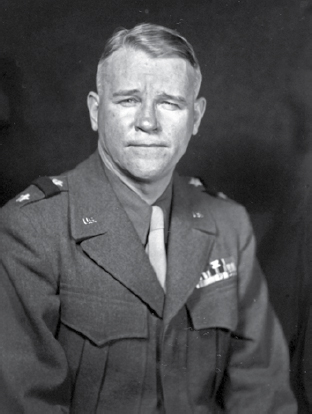
Major-General J. Lawton “Lightning Joe” Collins, commander of VII Corps. (NARA)
With one exception, Collins was blessed with excellent divisional commanders. Not surprisingly, the two airborne division commanders were exceptional, but neither division figured prominently in the final Cherbourg campaign. The infantry division leading the assault on Utah Beach was the 4th Infantry Division, commanded by Maj. Gen. Raymond “Tubby” Barton since July 1942. Barton was a notoriously strict disciplinarian but he also proved to be an excellent trainer. He led the division through the autumn campaign, culminating in the ferocious Hürtgen Forest campaign that gutted the division. He was relieved for medical reasons by George Patton in December 1944. The 9th Infantry Division, headed by Maj. Gen. Manton Eddy, was a veteran of the North Africa and Sicily fighting and widely regarded as one of the Army’s best divisions. Eddy was a particularly capable officer and in August 1944 was given command of XII Corps in Patton’s Third Army. The 79th Division was commanded by Maj. Gen. Ira Wyche, West Point class of 1911. Wyche had served in the field artillery until assigned to command the 79th Division in May 1942, leading it in its combat debut in 1944.
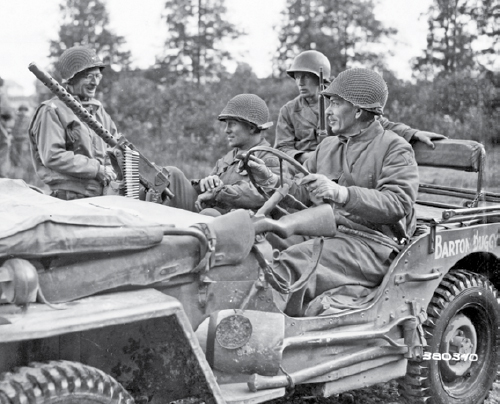
Major-General Raymond “Tubby” Barton, commander of the 4th Division is seen here at the wheel of his jeep “Barton Buggy.” He is talking with Col. Charles T. Lanham, who took over command of the 22nd Infantry in July 1944 after Lt. Col. S. Brumby was wounded in action. (NARA)

Major-General Manton Eddy, commander of the 9th Infantry Division, seen here during the fighting in Cherbourg in June 1944. (NARA)
Of all the divisions in Collins’ VII Corps, the only division to suffer from serious leadership problems was the 90th Division, led by Maj. Gen. Jay MacKelvie. An artilleryman, MacKelvie showed little affinity for infantry operations and was relieved by Collins on June 12 after five days of combat, along with two of his regimental commanders. His immediate replacement was a Pacific veteran, Maj. Gen. Eugene Landrum, who had commanded the 7th Infantry Division during the fighting with the Japanese in the Aleutian campaign. He was relieved by Bradley in August 1944 and was replaced by Maj. Gen. Raymond S. McLain in yet another shake-up in leadership of this troubled division.